In the World of Needlework Books, there are books, and then there are Books. Stumpwork Medieval Flora by Jane Nicholas falls into the latter category: it’s a Book you need in your needlework library! Here’s an overview of it.
Jane Nicholas is an Australian needlework designer who specializes in stumpwork embroidery. She has multiple books on the market that feature her stumpwork projects in all their glory – projects that captivate any avid embroiderer and enchant even those who aren’t needlework prone. Her newest book, Stumpwork Medieval Flora, does not disappoint. In the introduction, Jane notes that, like Medieval illumination, stumpwork is a surprise – it begs the viewer to close inspection and delights with each new discovery within a design.

Stumpwork Medieval Flora, an ample hard-bound book about an inch thick, features sumptuous pictures of the many projects featured in the book, along with complete materials lists and thorough instructions for completing each project. The book is divided into four sections: a brief introduction to the subject of medieval flora in illuminated manuscripts and their adaptation to stumpwork, the botanical specimens projects, the illuminated panels projects, and the final section on techniques, equipment, and stitches.
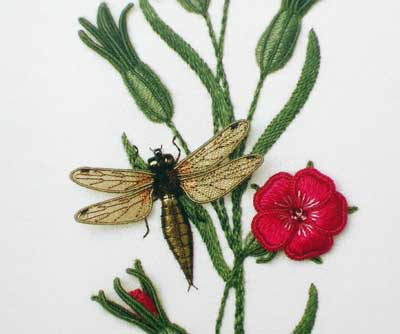
The front cover of the book features three of the five botanical specimens project (the other two specimens wrap around to the back cover). These “speciments” are can be stitched either as separate panels – each specimen individually – or they can all be stitched on one larger panel.
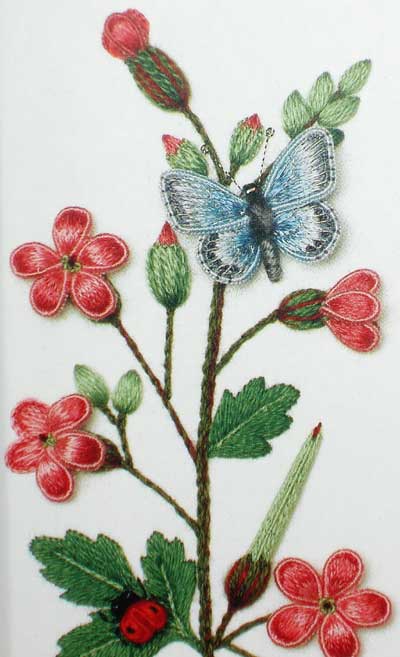
Each specimen illustrates a type of flora common to Medieval illumination, and along with the plant comes a good selection of very appealing insects. At the base of each speciment, the Latin name of the flower can be stitched.
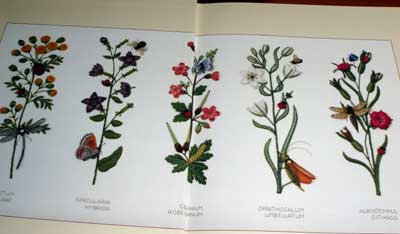
The “surprise” of these stumwork pieces does not come merely from the litle bug tucked here or there. While these are certainly fascinating (and downright beautiful – yes! even though they are bugs!), the “surprise” that awaits the close observer is the technique. Close inspection reveals the leaf ruffled by the wind, the twisted petal, the shaded bud, the dragonfly’s transparent wing and the beetle’s shiny armor, the butterflies fuzzy abdomen – all meticulously executed with needle and thread.
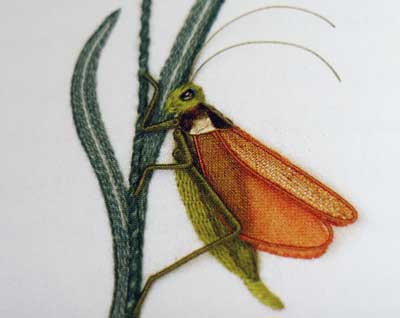
Without even looking at the instructional content, you’ve probably realized that the book could stand alone as a coffee-table conversation piece, it’s so darned beautiful!
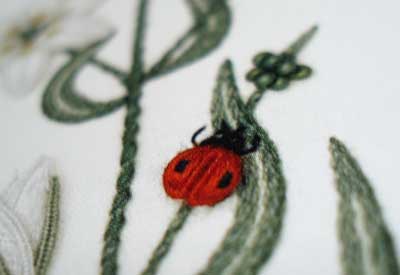
But, let’s look at the insides, too – and the meat of the matter, for those of us interested in needlework technique.

Within the book, the author instructs on a total of eight projects – five speciments and three illuminated panels. The specimens are those individual sprays featured on the cover. The panels are somewhat more formal – they feature a slightly less “natural” spray of flower or plant, bedecked with bugs and the like, and encased in a vivid frame of colored silk and gold thread.

A materials list is presented for each of the eight project. The list includes all fabric, fibers, and embellishments required to complete the project.
Line-drawings of the patterns (in the actual size to be worked) are accompanied by templates for the raised elements in each design.
The order of work is presented for each project, taking the reader step-by-step through the process of embroidering the particular design.
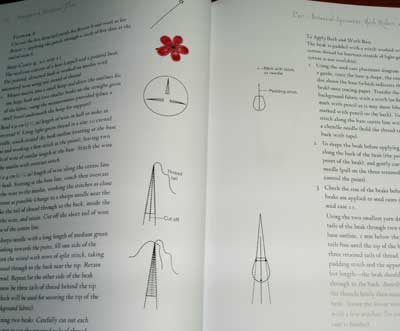
Little details of instruction are demonstrated with drawn diagrams. Most of the instruction, though, is in the text. The diagrams simply serve to clarify the text. Jane’s text instructions in all of her books are very well and clearly written.
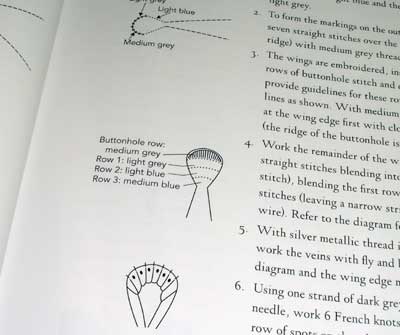
Mixed in among the text instructions and diagrams are up-close photos of the particular elements, completed. This is a nice touch; it not only adds interest to the black-and-white sections of the book, but it gives the reader a focused look at the element for the sake of reference.
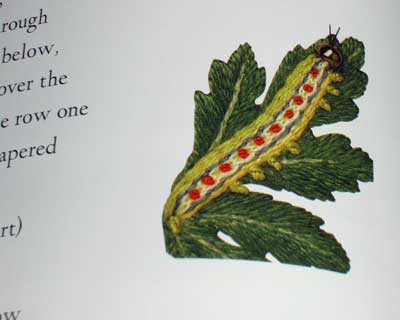
These finished elements are printed larger than their completed size, in order for the reader to see the details of stitching and placement.
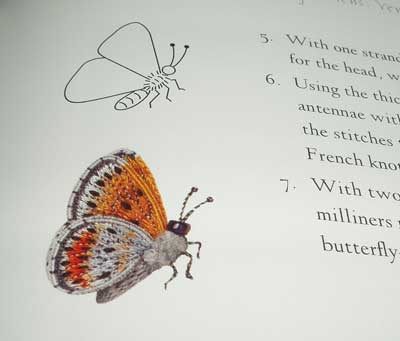
You can see here, for example, the line drawing of the butterfly accompanied by an enlarged image of the completed little beauty.
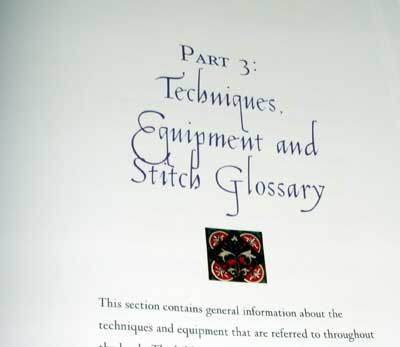
In the chapter on technique, equipment, and stitches, the reader will receive all the necessary “background” information for setting up the project, organizing and gathering supplies, the correct tools to use, and how to work the general types of stitches in the featured projects. The book, though, is not intended absolutely for beginners – unless you happen to be a very determined and enthusiastic beginner. For beginners, it would be helpful to have a few other reference books handy for stitch instructions, and Jane notes this at the back of the book (giving, in fact, a good list of resources available).
Book Depository has Stumpwork Medieval Flora available with free world-wide shipping, and you can also find it through Amazon:




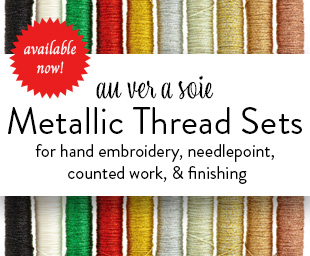
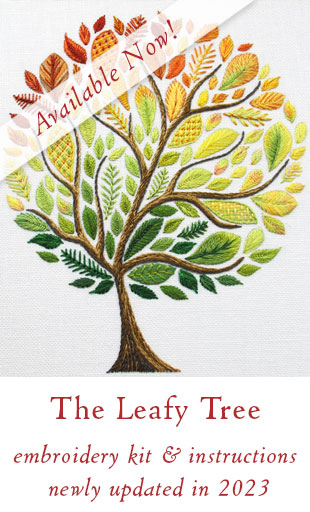
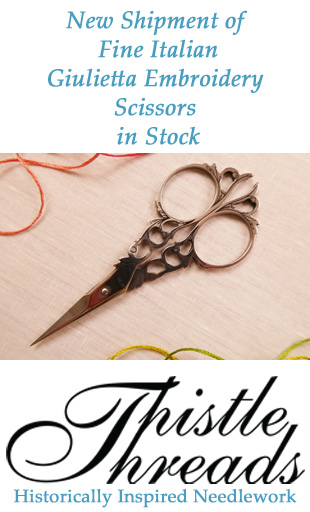
One item instantly added to the TOP of my wish list.
Great review Mary, thank you.
Oh my, how beautiful! I have to order it today. I've never attempted stumpwork because most of the designs I've seen are not that interesting to me, with heavy looking dimensional wool, etc. But THESE designs are just breath-taking. I know I'll have to find other resources as well to learn, I hope a beginner can master that dragonfly! Wonderful.
Wonderful review, Mary. It is nice to see some of the book's contents. I've had my copy on pre-order for months with Amazon and can't wait until it shows up (it keeps getting delayed ). I love Jane Nicholas's work. To me, she's simply the best stumpwork designer and I'm not even sure I'd be too interested in stumpwork if it wasn't for her.
). I love Jane Nicholas's work. To me, she's simply the best stumpwork designer and I'm not even sure I'd be too interested in stumpwork if it wasn't for her.
Thanks for the review, MC (not mariah carey :))!
I have the thick complete book of stumpwork, I also want the one with insects and now this!!! thanks for sharing!
Oh dear…another book has to be added to my already over-long wish list! This one however, might just be moved to the top of the list on the strength of your review alone! Thanks Mary.
Oh wow! Now I wish I had this book instead of her other big book. I need more direction and push with stumpwork. I think I shall have to add this to my christmas list. Thankyou for sharing!
Stumpwork is absolutely beautiful, but I've never tried it. I think it's one of those things that I could become obsessed with making all those intricate little creatures of nature!
Beautiful book…makes me want to try some more stumpwork. Thanks for sharing another great find with us!
Oh my God!!!
This looks beautiful, but I've never made stumpwork. Better said I knew what is stumpwork through you as well so many things about embroidery.
Thanks, Mary! – what else can I say?
Yup. It's going on my wish list, too. I picked up the book of medieval floral illustrations you recommended earlier this year, with the thought of turning something into stumpwork. It looks like Jane's taken the hard part out of the process! Thanks for turning us on to this book!
This looks like a lovely book, the work is amazingly beautiful. Makes me want to get out my thread and needles and get down to doing one!
Thanks!
Oh my gosh, what a marvelous book. I love the way the stumpwork stitches make the flowers and wings translucent. WOW would I love to own this baby.
Hugz and Blessings Audrey
This work is amazingly detailed! I would love to add this book to my library. But more importantly is that I would try this. I love my gardens and I take alot of detailed pictures of my flowers and yes, the bugs and hummingbirds too. To have a piece of this work hanging in my home would be wonderful.
Well, it looks like once more the beauty of nature will be captured forever in needlework. What a
wonderful thing to share with us Mary, thanks from the bottom of my heart. What's that….I hear the little bugs of the world rejoicing in this book…they have moved up a notch on the chain!
I have her other books. She does such a wonderful job in teaching, showing you how with easy to follow instruction and beautiful designs. I use stumpwork in almost everything I do. I need that added dimension on needlepoint, cross stitch and embroidery. I was excited to see she has another book out. Wounderful job!
It would be a blessing to have this book.
Debra
I appreciate the thorough review. As another reader commented, these designs are different from other stumpwork, they're so fresh!
I'm a crazy quilter. Stumpwork fits right in with other dimensional embellishments used on crazy quilts and I've been meaning to learn more about it and learn to do it. Thanks for the review. Beautiful designs.
Thank you so much for this review! It fills in gaps for me w/information. I LOVE stumpwork for the dimension and movement that it brings to a piece. I stitch quite a bit of "nature" and this looks like it will be a wonderful addition to a library!
I would dearly love a copy of this book. The illustrations are magnificent!
Stunning book, it is definately on my wish list also!!
Thank you so much for your review!
Jane
Hi Mary! Just joined this awesome community and am happy to find so many others as captivated by needlework as I am! (perhaps I should look for a house cleaning site to get excited about too!) This looks like a delicious book, with more possible future projects — tops on my X-mas list now.
Thanks! jjb
Got so excited I forgot to answer the question. I love stumpwork for the added 3-dimensional effect,
realistic touch and learning to master a new technique.
Thanks! (again)
Julie B
What I love about stumpwork is how it makes you really look at it and want to touch it because it just jumps out at you. How can you not want to see if a dragonfly's wings actually move? It's beautiful embroidery multiplied by 3D. I've never done it before but would love to try it.
Until your review, I had never heard of Stumpwork. Looking at the pictures that you show from this book – Wow, can you really make something that begs to be touched like the pictures show? Now I'm trying to find out more about the technique. Thank you for the keeping us up on possibilities.
Mary, Mary, Mary once again you have brought us beauty. Isn't it amazing that this wonderful craft have survived thru the ages. The details are the real deal. Ah to perfect this skill, methinks I shall try. Onita
Stumpwork is an amazing art and the perfect marriage between embroidery and sculpture.
Stumpwork is an amazing art and the perfect marriage between embroidery and sculpture.
I love the dimensional aspects of Stumpwork. A flower petal here, a leaf there. I can't wait to see this new book in person.
Julie
In San Diego, CA
Thanks for the review. I love the 3D affect of stumpwork and the way it makes you want to touch it. and this books looks like a winner I will have to see if I can sweet talk the hubby in to an early Birthday book.
Dear Mary, I'd SOOOOO love to win this book (so I don't have to go out and buy it which I can't afford.) Stumpwork is one of my favorite types of needlework. You really want to touch it with all its various depths, lengths, and breadths. This medium really holds one's attention and fascination. …..Judy in Pittsburgh
I have recently learned Stumpwork and I am in love with it. I especially love the Red Rose done in the new book. It looks like the Lancashire (England) Rose. I think I will make it for my husband.
Carol in FL
Hi Mary….what a beautiful book. I have been very fascinated by stumpwork since I first discovered it about 4 years ago. I had to pick my jaw up from the floor when I saw the bugs in particular. I couldn't believe that embroidery has gone so far as to be sculptural. I am an artist, and I do design work, painting, etc. One of my favorite things to do is to include painted ladybugs into some of the cards I make to give away. I would LOVE to do a stumpwork ladybug, bumblebee, dragonfly (I painted these all over my shower wall tiles!), and include them in gifts to my friends and family. It might even inspire them to do needlework, especially stumpwork. Also, I had seen a book from our library on stumpwork – this was where I discovered it – but the book has long disappeard, and I haven't been able to find any books with this form of needlework since then.
Excellent review of a beautiful book.
Hi,
Stumpwork has always stumpped me as they look so real and have used varied stitches in a different methodology!
Hi,
Stumpwork has always stumpped me as they look so real and have used varied stitches in a different methodology!
Hi Mary, thank you for another review of another great book.
Stumpwork mesmerizes and fascinates me, and is the one style of embroidery I am actually afraid to attempt.
The embroidered items look very real and life-like and I think this is what both fascinates & frightens me.
I endded up buying it and… oh what a beautiful book!! Thanks for reviewing it.
Wow, I am stumped! What a beautiful book…is this real?
Can some one teach me please the nuances!
Magnifique, aussi beau que la réalité de la nature.
Dear Mary,
The book you let us see, is a beautiful book, and challenges you to make something. And for my it is a challenges because I have never make something like this.
But it is a beautiffull book and really something that `i want to buy.
dear mary :
When I see these things I feel I see a three-dimensional – drawing – paintings.varied stitches in a different methodology! it is a beautiffull book and really something that I want to buy.Stumpwork is one of my favorite types of needlework. would love to add this book to my library.I rush learning to master a new technique.thanks